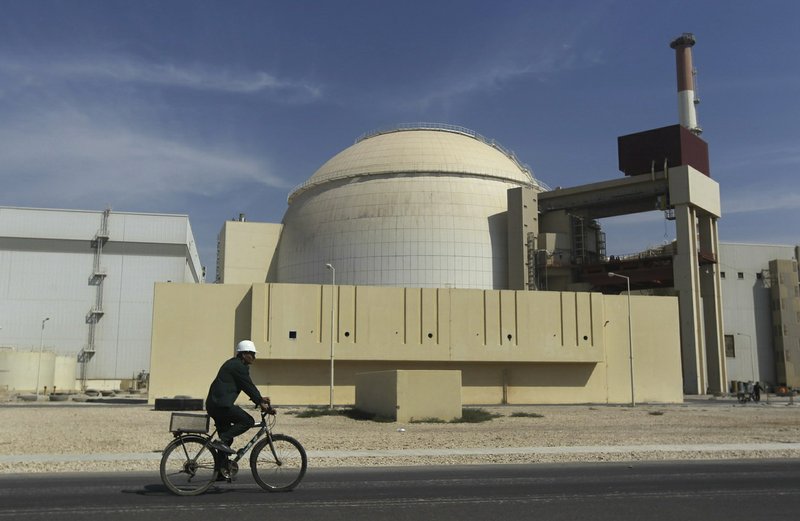Full extent of Iran’s nuclear defiance becoming clear

The latest developments regarding Iran’s nuclear program point to the fact that Tehran’s nuclear file is filled with secrecy, violations, defiance and clandestine activities. It was reportedthis week that an undeclared nuclear site in the city of Abadeh was used to conduct “experiments to develop nuclear weapons.” The site was disclosed in a trove of information that was obtained by Israeli agents from an Iranian warehouse last year. The Iranian leaders have been silent with respect to what the site was and why it was recently demolished, as satellite images apparently show.
The Iranian government also tooka third step toward achieving its nuclear ambitions on Saturday. The Atomic Energy Organization of Iran (AEOI) declared that it has activated 40 advanced centrifuges — 20 IR-4s and 20 IR-6s — for research and development purposes. The previous two steps Tehran took in moving away from the nuclear deal were increasing its enriched uranium stockpile beyond the 300-kilogram cap set under the Joint Comprehensive Plan of Action (JCPOA) and enriching uranium beyond the limit of 3.67 percent.
As part of its nuclear defiance, Iran is also expanding its research and development work beyond the limitations set by the JCPOA. AEOI spokesman Behrouz Kamalvandi tolda televised news conference: “We have started lifting limitations on our research and development imposed by the deal... It will include development of more rapid and advanced centrifuges.”
The theocratic establishment is spreading the narrative that Europe and the US are to blame for Tehran’s violation of the nuclear deal. Supreme Leader Ali Khamenei previously set out a list of demandsfor the European powers to fulfill if they still wanted Iran to comply with the nuclear deal. Tehran’s demands were mainly economic and geopolitical, including ensuring the continuation of Iranian oil exports, protecting oil sales from US sanctions, safeguarding Iran’s trade with Europe, and not seeking any negotiations over Tehran’s ballistic missile program or its regional and foreign policies.
Iran has clearly been blackmailing the Europeans. And, from the perspective of the Iranian leaders, the Europeans have failed to meet the 60-day deadlineit set in July.
The European powers’ efforts to satisfy the Iranian regime’s demands have indeed been unsuccessful. They came up with a special purpose vehicle to facilitate trade and payments to Tehran, but it has failed. Even though the European governments agreed to participate in the plan, corporations, firms and private financial institutions have been reluctant to do so because of the repercussions. It quickly became clear that the European business giants were not willing to run the risk of losing access to the $18 trillion US market for the sake of Iran’s $400 billion market.
In addition to blaming the Europeans, Iran is also pointing a finger at its rival, the US. After all, it was the White House that withdrew from the nuclear deal. But the mullahs’ blame game ought not to distract the international community from the larger picture. The JCPOA was never a permanent solution to Iran’s nuclear threat and, more importantly, new evidence points to the fact that Iran was most likely not in compliance with the nuclear deal from the outset.
Do you remember when Israeli Prime Minister Benjamin Netanyahu urged the chief of the International Atomic Energy Agency (IAEA) to immediately “inspect this atomic warehouse” last year? Netanyahu stated in his speech to the UN General Assembly that Iran had a “secret atomic warehouse for storing massive amounts of equipment and material from Iran’s secret nuclear weapons program.” Tehran claimedthat the warehouse, which is located in the village of Turquz Abad in the suburbs of Tehran, was a factory where carpets were cleaned.
At the same time, two nonpartisan Washington institutes — the Institute for Science and International Security (ISIS) and the Foundation for the Defense of Democracies (FDD) — releaseddetailed reports about Iran’s undeclared clandestine facilities. The IAEA ignored the reports at first but, after its chief passedaway and after Iran was reported to be capable of movingsuspect materials out of the facility, the site was inspected almost a year on. And what was the outcome? Even though Iran had cleaned up the facility, the inspectors were able to detect radioactive particles. In other words, Israel’s warning and other reports proved to be accurate.
Now Tehran is declining to answer the IAEA’s questions about Turquz Abad. More fundamentally, under the terms of the JCPOA, Iran is obliged to reveal its nuclear activities. In other words, the detection of radioactive particles at Turquz Abad, Iran’s reluctance to answer simple questions about the hidden facility, and nonpartisan evidence about Iran’s activities at the location all point to the notion that Tehran was most likely violating the nuclear deal from day one.
The mullahs’ blame game ought not to distract the international community from the larger picture.
Dr. Majid Rafizadeh
This should emphasize the IAEA’s failure to detect or follow up on credible reports about Iran’s illicit nuclear activities on several occasions in the past, including revelations about clandestine nuclear sites in Natanz and Arak, which were first revealedby the oppositional group the National Council of Resistance of Iran.
The proponents of the nuclear deal appear to be silent in the face of the new evidence that suggests the Iranian regime has been most likely violating the agreement ever since it was reached in 2015. This also buttresses the argument that the JCPOA was never a long-term solution to Iran’s nuclear threat.
- Dr. Majid Rafizadeh is a Harvard-educated Iranian-American political scientist. He is a leading expert on Iran and US foreign policy, a businessman and president of the International American Council. Twitter: @Dr_Rafizadeh









































